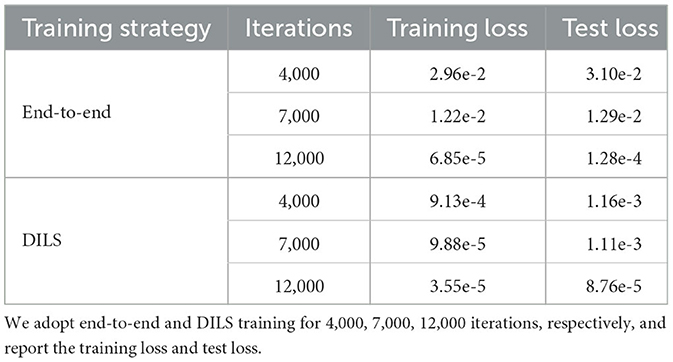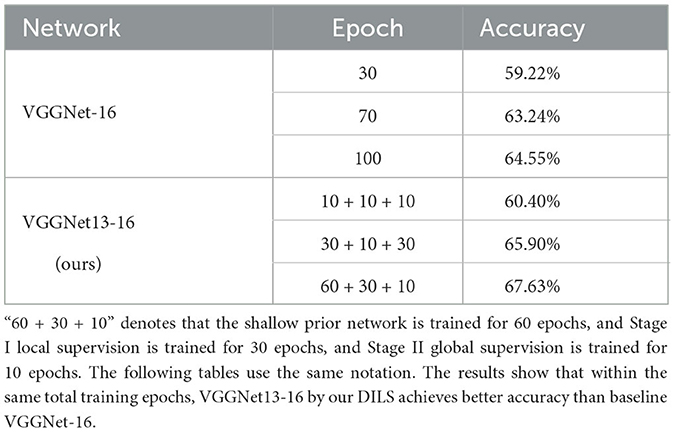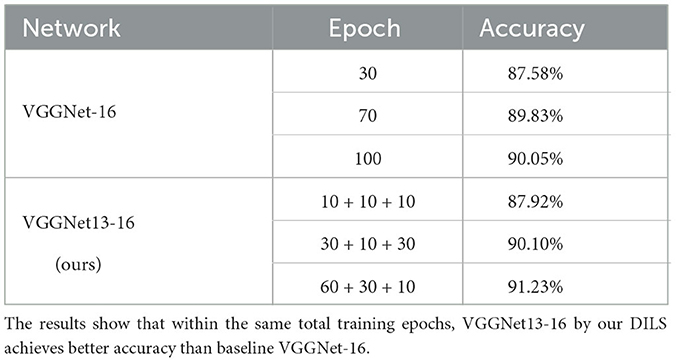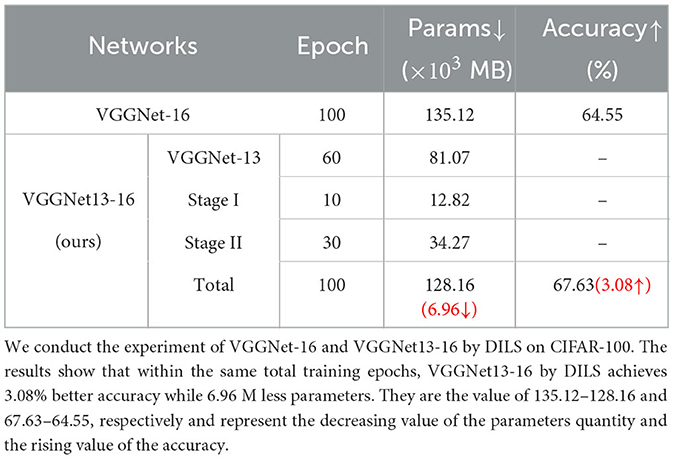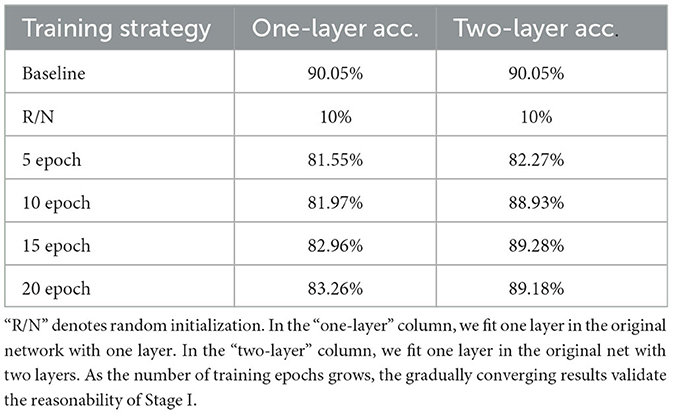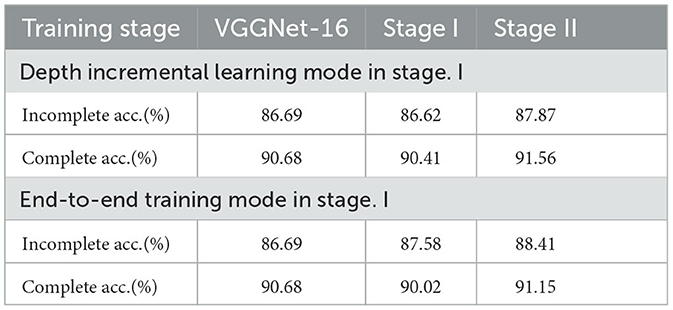- 1State Key Laboratory of Robotics, Shenyang Institute of Automation, Chinese Academy of Sciences, Shenyang, China
- 2Institutes for Robotics and Intelligent Manufacturing, Chinese Academy of Sciences, Shenyang, China
- 3University of Chinese Academy of Sciences, Beijing, China
There exist various methods for transferring knowledge between neural networks, such as parameter transfer, feature sharing, and knowledge distillation. However, these methods are typically applied when transferring knowledge between networks of equal size or from larger networks to smaller ones. Currently, there is a lack of methods for transferring knowledge from shallower networks to deeper ones, which is crucial in real-world scenarios such as system upgrades where network size increases for better performance. End-to-end training is the commonly used method for network training. However, in this training strategy, the deeper network cannot inherit the knowledge from the existing shallower network. As a result, not only is the flexibility of the network limited but there is also a significant waste of computing power and time. Therefore, it is imperative to develop new methods that enable the transfer of knowledge from shallower to deeper networks. To address the aforementioned issue, we propose an depth incremental learning strategy (DILS). It starts from a shallower net and deepens the net gradually by inserting new layers each time until reaching requested performance. We also derive an analytical method and a network approximation method for training new added parameters to guarantee the new deeper net can inherit the knowledge learned by the old shallower net. It enables knowledge transfer from smaller to larger networks and provides good initialization of layers in the larger network to stabilize the performance of large models and accelerate their training process. Its reasonability can be guaranteed by information projection theory and is verified by a series of synthetic and real-data experiments.
1 Introduction
Modern deep learning models typically have complex network structures and a large number of parameters, requiring significant computing resources and time for training. Therefore, researchers have begun exploring methods for transferring knowledge from pretrained models to new models in order to speed up the training process and improve their performance. However, current knowledge transfer methods are typically based on networks of the same size (Yang et al., 2023), such as weight sharing, feature transfer, or knowledge transfer from deeper to shallower networks (Huang et al., 2022; Shi et al., 2023), such as knowledge distillation, and network pruning. There is a lack of knowledge transfer strategies from shallower to deeper networks. With the development of large models and frequent updates, network sizes have become increasingly larger. Research on knowledge transfer methods from small to large models is necessary. However, several reasons prevent the realization of such knowledge transfer. One reason for the limitation of knowledge transfer from smaller to larger networks is the inability to initialize redundant layers and parameters in the larger network. Traditional end-to-end training wastes a significant amount of time and computing power, restricts network flexibility, and hinders the inheritance of prior knowledge. We aim to propose a training strategy that enables knowledge transfer from smaller to larger networks and provides good initialization of layers in the larger network to stabilize the performance of large models and accelerate their training process.
To solve this issue, we consider an incremental learning strategy. The idea is motivated by the data regression via continuous numerical approximation, e.g., polynomial regression. As shown in Figure 1, by adding the degree of the polynomial, it can increase the regression accuracy for a given set of data. Similarly, as the net deepens, its ability may be enhanced gradually, e.g., more accurate object detection. Similarly, by adding new layers to the network, it can achieve better scalability while inheriting the original performance.
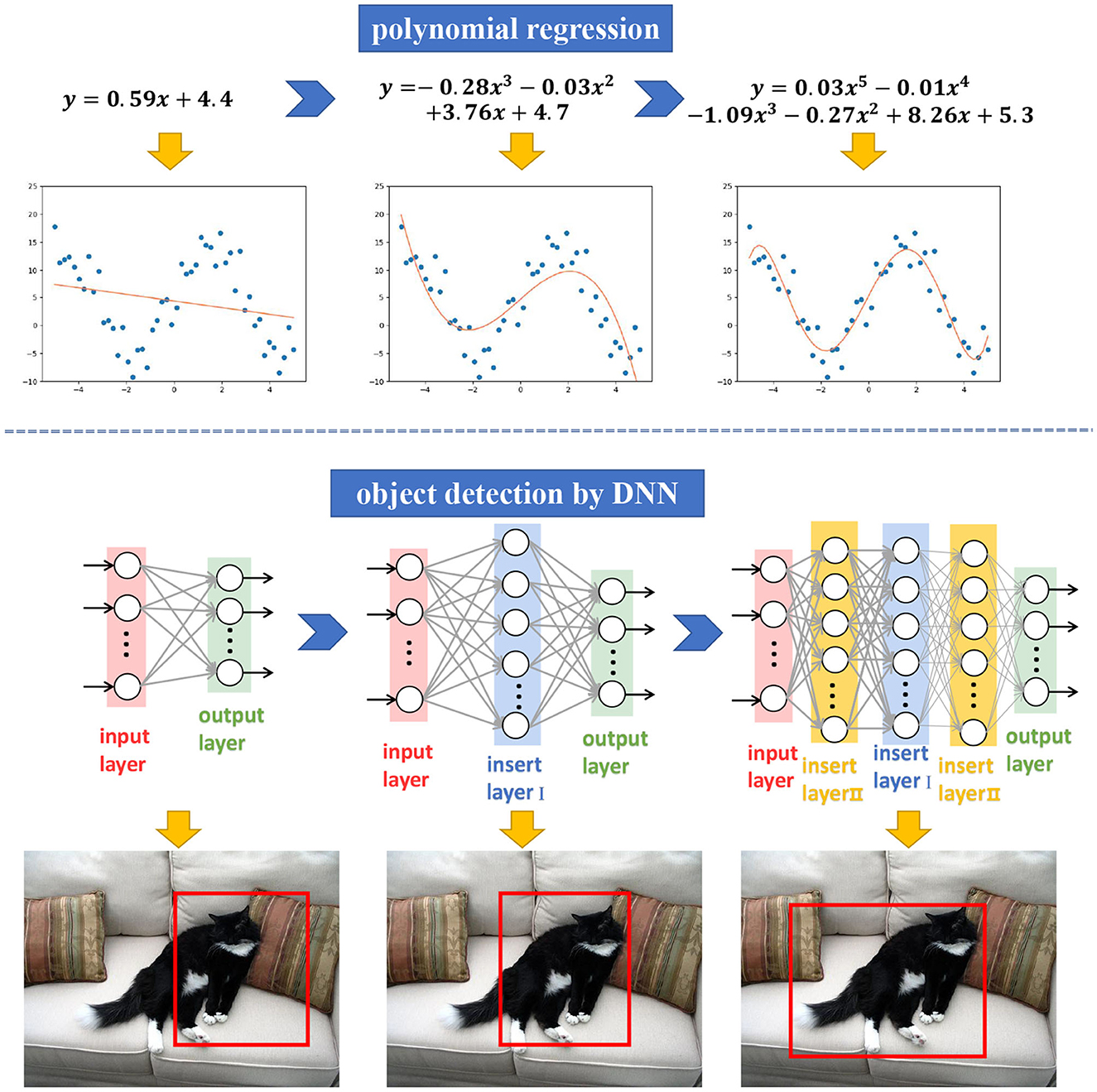
Figure 1. Regression ability gets better along with polynomial degree getting higher. Similarly, performance increases along with network getting deeper.
We name this strategy the depth incremental learning strategy (DILS). The main idea is illustrated in Figure 2. For a given shallower net (e.g., 4-layer), a set of new layers are inserted (colored orange, yellow, and green, respectively), whose connections with the original layers are trained based on the original network. Then, a new deeper net (7-layer) is obtained, which realizes a flexible ability increment. By repeatedly performing such operations, the net depth increases gradually and achieves knowledge transfer from a small network to a large network.
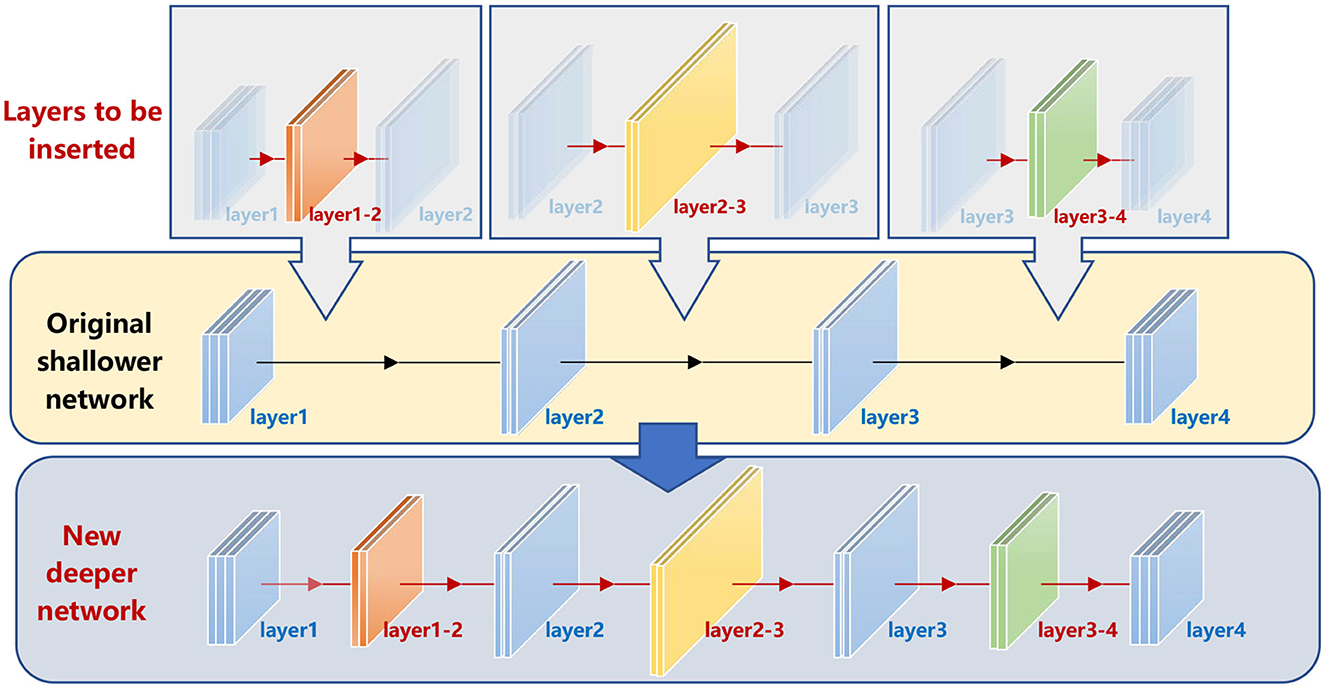
Figure 2. Depth incremental learning model. The original shallow net is well-trained. Then, we insert the orange, yellow, and green layers to the original net. In the Stage I training process, the mapping relations of the original net are invariant to realize stability-based supervision. Then, the new deeper net inherits information of the original shallower net. At the same time, with the number of layers increasing, the solution domain of the mapping relations is expanded, so that the stage II plasticily-based superbision is complished.
There are three benefits of the proposed DILS. First, it realizes a continuous learning sequence. The new deeper net is generated based on the shallower net, which has been already well-trained. Thus, it inherits the learned knowledge from the shallower net. Consequently, it gives the new net a good “initialization” for further training. Second, it saves plenty of computing resources by deepening the network gradually to find the best fitting depth of the network. It starts from a shallow net, which is easier to train. The subsequent training for the inserted layers each time is also very easy and time-saving because the new layers are well-initialized based on the original net. Furthermore, it is very flexible for both learning procedure and actual implementation. In other words, the training procedure can stop at any depth to meet the required accuracy. Imagining the following scenario, at the beginning, we want to deploy a network on a light device of lower computing power and do not demand very high task accuracy. Then, a shallow net is enough and suitable. But later, we update the device with higher computing power and become caring more about the accuracy. We can just deepen the previous network to increase the performance within very short training time.
The reasonability and effectiveness of DILS can be explained in both biological systems and computational models studies, and it is well-admitted that an efficient training procedure should make a good balance between stability and plasticity (Ditzler et al., 2015). The mechanisms of neurosynaptic plasticity regulate the stability–plasticity balance in multiple brain areas (Douglas et al., 1995). On the basis of shallow network prior, local stability supervision ensures the performance of the network, while global plasticity supervision enhances the network's efficiency.
It can also be interpreted as an information projection procedure (Zhu and Mumford, 1997; Zhu et al., 2010; Si and Zhu, 2011). From the statistical aspect, the goal of a deep net is to learn a distribution p to approximate the distribution q of a given task. DILS tries to find a sequence of models pi, which can gradually approach q, as shown in Equation (1):
in terms of minimizing the Kullback-Lebler divergence KL(q ∥ p). For each step, the incremented net is pursued by the following optimization problem, as shown in Equation (2):
To sum up, the main contributions of this study are as follows:
• We propose a depth incremental learning strategy (DILS), which enables knowledge transfer from smaller to larger networks and provides good initialization of layers in the larger network to stabilize the performance of large models and accelerate their training process.
• The methods for optimizing the new added parameters along with the new layers are proposed, which guarantees the new deeper net inherits the knowledge learned by the original shallower net.
• DILS enhances the efficiency and flexibility of deep network training, which is verified by a series of synthetic and real-data experiments.
2 Related studies
In this section, knowledge transfer methods between networks are initially introduced, followed by a discussion of the more widely researched knowledge transfer method from large networks to small networks, known as network compression.
2.1 Knowledge transfer between networks
The common methods for knowledge transfer between networks include fine-tuning, feature extraction, model distillation, and pruning. Fine-tuning (Yosinski et al., 2014) is a knowledge transfer method that involves using a pretrained model as the initial parameters and continuing training on a new task. During the fine-tuning process, the learning rate is usually decreased to avoid disrupting the weights of the pretrained model, and data augmentation is applied to the new dataset to prevent overfitting. Fine-tuning has become one of the most common knowledge transfer methods in computer vision. Feature extraction (Chatfield et al., 2014) is a knowledge transfer method that involves using a pretrained model to extract features, and then passing these features to a new model for classification. Typically, the convolutional layers of a pretrained model are used as the feature extractor, and the features are then passed to fully connected layers for classification. This method is usually more stable than fine-tuning and requires fewer computing resources. Model distillation (Hinton et al., 2015) is a knowledge transfer method that involves using a larger model (usually called the “teacher model”) to “teach” a smaller model (usually called the “student model”). During the training process, the student model attempts to replicate the predictions of the teacher model in order to transfer its knowledge. This method can reduce the size of the model, thereby improving its efficiency (Lan et al., 2022; Hu et al., 2023). Model pruning (Han et al., 2015) is a technique of compressing the model's size by removing unimportant neurons or connections. One can use pruning on a pretrained model, followed by fine-tuning or feature extraction to transfer knowledge, whereas fine-tuning and feature extraction are mostly based on networks of the same size, and knowledge distillation and pruning involve transferring knowledge from large to small networks, our method achieves knowledge transfer from small to large networks.
2.2 Neural architecture searching methods
Neural architecture searching (NAS) aims at designing an appropriate neural architecture that achieves the best possible performance. NAS implemented by reinforcement learning (RL) methods has reached state-of-the-art accuracy results on image classification tasks. This demonstrates that automated neural architecture design is feasible (Baker et al., 2016; Jaafra et al., 2019). However, NAS consumes a large amount of computing resources, which is catastrophic for reproduction (Zela et al., 2020) and further research (Pham et al., 2018; Bashivan et al., 2019; Zheng et al., 2019). Even more unfortunately, it is extremely task-specific and lacks of plasticity. For even a small change to the original task, the learned architecture may exhibit poor performance, and it has to search a new neural architecture to solve the slightly altered task. In comparison, DILS is very plastic by gradually incrementally inheriting and learning a series of networks of different depths that can deal with this situation flexibly. More importantly, DILS can realize knowledge inheritance from small structure networks to large ones.
2.3 Network compression methods
Network compression methods are developed to speed up computing and save storage space. Among them, low-rank decomposition-based approaches (Oseledets, 2011; Kim et al., 2015; Zhao et al., 2016) conduct decomposition on convolutional filters that are viewed as matrices or tensors. Pruning-based approaches (Wen et al., 2016; Li et al., 2020) compress the network by deleting relatively unimportant weights on different levels, including the filter, channel, and layer levels. Knowledge distillation based approaches (Choi et al., 2022; He et al., 2022) extract knowledge from the teacher network and derive a more compact student network.
Although the network compression method can realize a more lightweighted architecture. However, the compression procedure is also time-consuming and sometimes difficult to calculate. In comparison, DILS starts by training a shallow network, which saves plenty of computing resources. Furthermore, it is very flexible to grow to an appropriate depth to meet the required accuracy. Network compression facilitates the transfer of knowledge from larger networks to smaller networks. Conversely, DILS serves as a complementary technique by enabling knowledge transfer from smaller networks to larger networks.
3 Proposed method
3.1 Depth incremental learning strategy
Suppose for a target task y = f(x), we already have an L-layer deep nets for approximating the function f,
in which, L ∈ ℕ is the depth of the network, dk and are the width and the feature map of the kth hidden layer, respectively. is the weight of the output layer. σ(·) is activation function, e.g., Sigmoid, ReLU. “*” here represents the operation between features and input feature maps, which can be fully-connect, convolution, etc.
We aim to achieve knowledge transfer from a small network to a large network.
of depth L + l based on h{d0, ⋯ , dL, σ}, satisfying Equation (5)
Here, ∥·∥ measures the approximation error of network H to the target function f.
For realizing such goal, we provide a two-stage learning strategy:
Stage I: Insert new l layers (as shown in Figure 3) and initialize the new parameters based on the old shallower network HL by solving the following optimization problem as shown in Equation (6)
For one specific new layer (e.g., the ikth), supposing it is inserted between the (mk − 1)th and the mkth layer of the old network, the original parameters Wmk (the connection between the (mk − 1)th and the mkth layer) are replaced by and , which are the new connections of the ikth layer with the (mk−1)th and the mkth layer, respectively.

Figure 3. Illustration of stage I. Assume that the original net is with two layers. We add a new layer to the net to boost its expressive capability. To ensure that the newly added layer has good initialization, local stability supervision is employed to make the effect of the inserted net equal to the original net.
Stage II: Fine-tune the initialized network by a small set of training data and comparatively less epochs.
The two-stage strategy makes the new network inherit the learned knowledge of old network so that realizes the continuity of incremental learning and make it much easier to train the deeper network.
For better guaranteeing the property of local stability so that further enhancing the training efficiency, we divide the problem (6) into l sub-problems as shown in Equation (7),
In the above optimization problem, we only consider the local network around the ikth layer of the new network. The goal is to reproduce the mapping relationship from the (mk − 1)th layer to the mkth layer of the old network, i.e., narrowing the differences of in the new network and in the old network based on the same input .
Ideally, if we have an operator ◦ representing the mapping relationship, as shown in Equation (8) and Equation (9),
and there exists a unique inverse operation of ◦, then we can easily reach the analytical solution of as shown in Equation (10)
where inv(·) represents the inverse operation. However, for networks with various operators and activation functions, the perfect situation is hard to realize. In the following, we will discuss how to provide a proper solution. In the following subsection, we will discuss two kinds of local network structures and provide proper solutions correspondingly.
3.2 Optimization for stage I
3.2.1 Fully-connected network
For a fully-connected network function, the relationship in Equation (4) can be written as Equation (11),
For simplicity, is replaced by X in the following part of this subsection. The solution of new inserted parameters can be obtained by solving Equation (12),
in which, σ(·) is ReLU function,
It is a piecewise function and is irreversible. Therefore, if σ(·) in the optimization problem (12) is ReLU, it is unrealistic to derive an closed form solution. For providing an analytical solution most possibly, we can utilize its property of sparsity.
Considering in (12), we notice that is sparse. Equation (12) can be regarded as a sparse coding problem as shown in Equation (13),
in which, S is the signal to be recovered, are a group of basis vectors, and z = [z1, z2, ..., zM] are corresponding coefficients. For the optimization (12), WmkX, and can correspond to S, B and z in Equation (13), respectively. By setting , we have following optimization problem as shown in Equation (14),
in which, η is a hyperparameter. This optimization problem can be solved by alternately calculating and Σw via an KSVD method (Bertin et al., 2007; Farouk and Khalil, 2012) with non-negative matrix factorization.
then can be obtained by solving the following problem, as shown in Equation (15),
where ⊙ is Hadamard product, and M is a index vector satisfying
The verification experiments of this part are shown in Section 4.2.
3.2.2 Convolution network
As the convolution operation makes tons of local computation and can be regarded as an severely sparse situation of fully-connection, it is too redundant to adopt the upmentioned algorithm. So, we use the chain derivative rule based on back propagation for solving the problem of convolution network.
To maintain generality, we adopt a functional representation for the multilayer neural network. In the functional representation, we view the neural network as a collection of mapping functions, with each function corresponding to a layer in the network. Assuming that we have a multi-layer neural network with L+1 layers. Each layer is represented by hi, where i ranges from 0 to L. We can define a functional as follows. Suppose that the original shallower net is trained and expressed as Equation (16), which is a variant of Equation (3):
where ◦ represents the composition operator for functions and denotes the output of the Lth layer. Each module or component is denoted as h. x is the input of the network, and the dimension of x is adjusted according to the batch size of the dataset.
The matter is how to expand the original shallower net to the new deeper net. We note the structural similarity between the shallower and the new deeper nets. To make better use of the trained network, a new depth incremental learning model against the traditional end-to-end training model is proposed. The method splits any component hi in as shown in Equation (17),
where z is the output of the functional before the i-th layer, which is represented as shown in Equation (18)
Then the optimization problem in Equation (6) is reformulated as follows:
According to Equation (19), the loss function is defined in Equation (20).
The parameters of fi and gi are updated according to the loss function to approximate the optimization objective in Equation (19):
4 Experiment
We conduct more experiments on CNNs for their extensive use, in terms of convergence, effectiveness, and exploration.
4.1 Experiment setup
We evaluate our proposed DILS on object classification tasks with the following configurations. (1) ResNet-20, ResNet-32, and ResNet-44 (He et al., 2016) on CIFAR-10 (Krizhevsky and Hinton, 2009) are used to test the convergence and the accuracy improvement of the approach. (2) VGGNets (Simonyan and Zisserman, 2014) on CIFAR-10 and CIFAR-100 are used to test the accuracy and efficiency improvements of the approach. (3) ResNet-18 and ResNet-34 (He et al., 2016) on ImageNet (Deng et al., 2009) are used to visualize the training process of end-to-end and depth incremental learning strategies.
In the following experiments, ResNet20-32 is used to represent that ResNet-20 is extended to ResNet-32 by inserting layers, similar to VGGNet16-19. All the experiments are implemented with PyTorch (Paszke et al., 2019) on an NVIDIA GeForce RTX 3090 Ti GPU and two Intel(R) Xeon(R) Gold 6240 CPUs @ 2.60 GHz.
4.2 Experiment on fully connected network
To verify the effectiveness of sparse coding with dictionary learning in dealing with Stage I local stability-based supervision, the fitting experiment of function is conducted. In total, 3,000 points are sampled uniformly from value −1 to 1 for the training set, and 200 points are sampled uniformly from value −1 to 1 for the test set. A four-layer fully connected neural network activated by ReLU is used to fit the function.
The results are shown in Table 1. DILS on fully connected network performs better than end-to-end training model for the robustness of Stage I local stability supervision. The reason is that sparse coding is another manifestation of depth incremental learning model, so the loss is closed to depth incremental learning model. However, sparse encoding does not provide the same excellent stability supervision as depth incremental learning model, so the results are slightly inferior.
4.3 Convergence validation of DILS
To demonstrate the convergence of DILS, we devised the following two experiments to test the convergence of the training process and results. The training process convergence experiment is performed on VGGnet13-16, while the experimental results convergence experiment is performed on ResNet20-32-44. Both experiments are performed on CIFAR-10.
Figure 4 depicts the feature convergence process of DILS, using 200 samples on VGGNet13-16 with CIFAR-10. First, a randomly initialized network is shown in Figure 4A. Then we train 20 epochs on the VGGNet-13, which is shown in Figure 4B. After that, localized supervision is applied to the new growth layer, which can guarantee the stability of the network, as shown in Figure 4C. Finally, global supervision is imposed on the entire network, exploiting the plasticity of the network to achieve better classification results. The finally result is shown in Figure 4D.

Figure 4. Feature convergence graph of training process of VGGnet13-16 on CIFAR-10. (A) The data points of each category are scattered due to random initialization. (B) After training VGGNet-13 for 20 epochs, the distribution of the features of the network shows a tendency to converge. (C) The Stage I local supervision ensures network stability, so that the figure is similar to the trained VGGNet-13 shown in (B). (D) After the stage II global supervision, which guaranteeing the network plasticity, the category distribution is more concentrated. The intra-class feature distance shrinks and the inter-class feature distance increases, which leads to better classification results.
4.3.1 Experiment results
To validate that the experimental results do not diverge with the increase of the inserted layers, the ResNet20-32-44 experiments on CIFAR-10 are established. The experimental results are shown in Table 2. By using DILS, the network depth increases from ResNet-20 to ResNet-32, further increasing to ResNet-44. The network accuracy steadily improves as the network depth increases. Due to the Stage I local stability supervision, the network shows no sudden drop in accuracy and benefits from the Stage II global plasticity supervision, and the result is improved to some extent.
4.4 Comparison of end-to-end learning strategy and DILS
4.4.1 Training process
Fully connected networks with function fitting: To compare the differences between the two learning strategies on training process, we fit with a four-layer fully connected network. Three-thousand points are sampled uniformly from value −100 to 100 for the training set. The training characteristics of the two learning strategies can be seen from the loss descent curve. In Figure 5A, the loss curve descends in steps for taking different learning rates 0.005 and 0.0005, while in Figure 5B, the curve drops continuously and converges faster with fixed learning rate 0.005. In the end-to-end learning strategy, the network converges after 12,000 iterations. However, in the depth incremental learning strategy, the same network converges after 3,000 iterations.
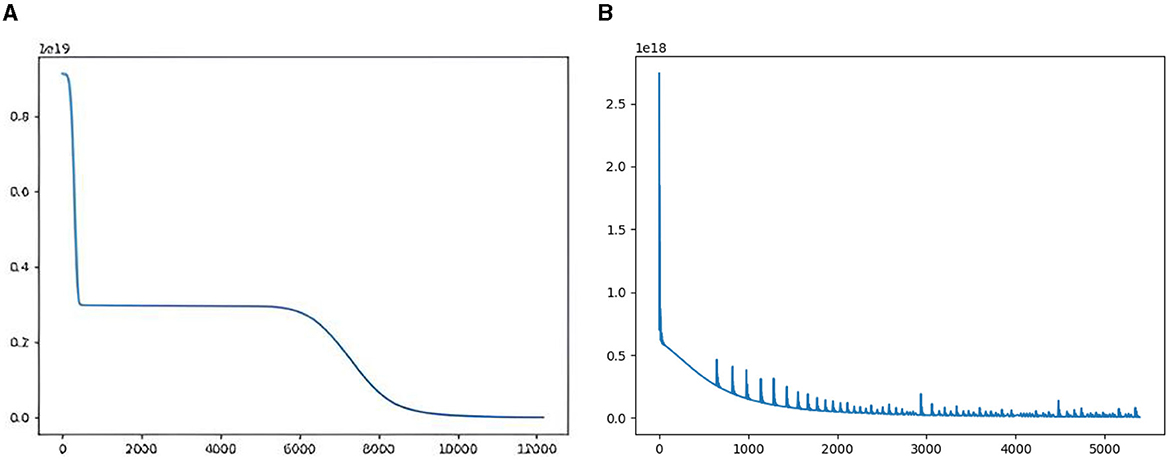
Figure 5. Comparison of end-to-end learning strategy and DILS. (A) Shows end-to-end learning strategy, where the loss falls in a stepwise manner. (B) Shows DILS, where the loss drops continuously and converges faster.
4.4.2 Experiment results
In order to prove the effectiveness of depth incremental learning strategy, two kinds of experiments based on VGGNet13-16 and ResNet20-32 network are established. In the VGGNet13-16 experiment, the number of epochs in end to end training model and depth incremental learning model are equal. In the ResNet20-32 experiment, the calculation amounts of both models are equal.
VGGnet with CIFAR-10 and CIFAR-100: To prove the effectiveness of DILS, an experiment based on VGGNet13-16 is established. The number of epochs in the end-to-end training model and depth incremental learning model are equal. The experimental accuracy and number of parameters quantity are compared. Two training models are trained in 30, 70, and 100 epochs on CIFAR-10 and CIFAR-100, respectively. The end-to-end training model is trained directly on VGGNet-16, and the depth incremental learning model is divided into three steps. The first step is training the original shallow VGGNet-13. The second step is Stage I local stability-based supervision. The third step is Stage II global plasticity-based supervision. The total epochs of the three steps are equal to the epochs of end-to-end training. The experiments are shown in Tables 3, 4. Table 5 shows parameters comparison of two learning strategies on VGGNet on CIFAR-100. The experiment shows that the training parameters decrease by 6.96x103 MB and the accuracy increases by 3.08%.
ResNet with ImageNet: To further observe the training process of DILS, experiments are conducted on the ResNet18-34 network with the ImageNet dataset. The pretrained ResNet18 network is used. Original shallow network, and in the first stage, local stability supervision is conducted for five epochs using MSE as the loss function, with a learning rate of 0.005. In the second stage, global plasticity supervision is conducted for 30 epochs with a learning rate of 1e-5. In fact, 10 epochs are sufficient to ensure the convergence of the DILS network. To facilitate comparison with the naive end-to-end network, we set the total number of epochs to 35. The learning rate of the plain end-to-end network is initially set to 0.1 and multiplied by 0.1 every 30 epochs. The experimental results are shown in the Figure 6. The experimental results demonstrate that the network trained using the DILS strategy can achieve faster convergence due to its ability to inherit prior knowledge from the existing network. Additionally, an interesting observation is that the MSE loss of the front layers in the network is relatively small, while the MSE loss increases as it gets closer to the back layers, as shown in Figure 6B. This may be because the deeper layers of the network contain richer semantic information, which is more important for the representation of the classification network.
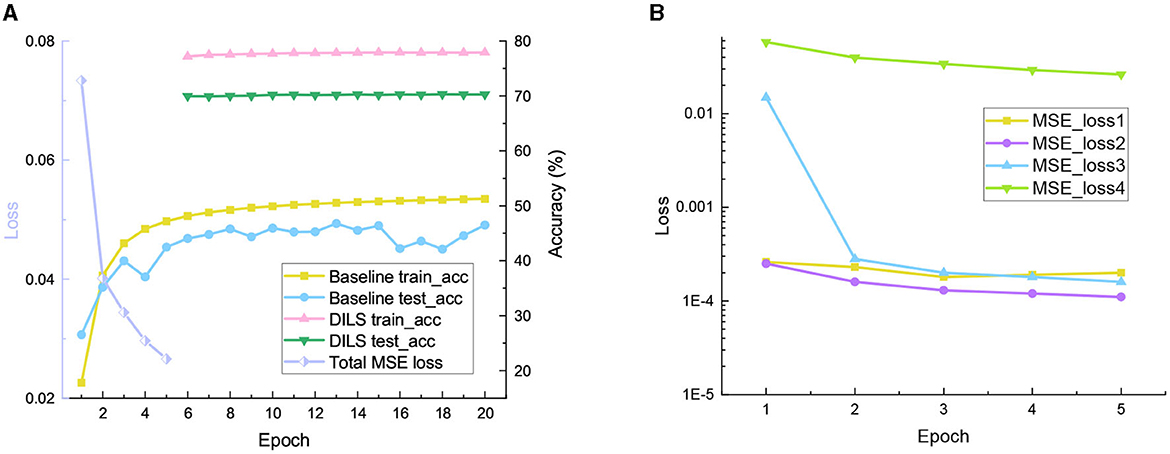
Figure 6. Experimental results on ResNet with ImageNet dataset. (A) Train accuracy, test accuracy, and total MSE loss. (B) The MSE loss for four positions in local stability supervision.
It is worth mentioning that the training model we proposed uses a single learning rate at each step, while the end-to-end training model uses multiple variable learning rates to obtain the best experimental results. The proposed model effectively alleviates the problem of learning rate adjustment in DNN training and obtains better experimental results.
4.5 Exploration of the rule on the DILS
To obtain better experimental results, we try to explore the general rule of DILS. A series of experiments are carried out in ResNet20-32. In Figure 7, different subfigures show different epochs in which Stage I is trained. For example, in the first subfigure of Figure 7, the I local supervision epochs of all curves are fixed to 2, and the rest of the subfigures are fixed to 4, 6, 8, 10, and 12 epochs in order. The chart abscissa represents the number of epochs training the original shallow net. Different color curves correspond to different epochs of Stage II. For example, “f5” in the legend indicates five epochs of the II global supervision. The optimal training number of the original shallow network is fixed at 80, regardless of how many epochs the local and the global supervisions are trained.

Figure 7. Rule of DILS on ResNet20-32. The six subfigures represent different epochs taken for the stage I local stability-based supervision, 2, 4, 6, 8, 10, and 12 epochs, respectively. For every subfigure, chart abscissa represents the number of epochs used for training the original shallow net and different curves correspond to different stage I global supervision epochs.
The reason for this phenomenon is that too few iterations cannot guarantee net stability, and too many iterations limit the plasticity of the net. Experiments show that the most plausible prior network exists. This reflects the scientificity of the proposed strategy.
4.6 The reasonability of the stage I
The proposed method makes use of the priors of the shallow network and it is extended to the deep network by fitting the original one layer with multiple layers. To validate its reasonability, an experiment is performed by randomly initializing the parameters of any layer in the well-trained VGGNet-16 on CIFAR-10, as shown in Table 6. Then, by extracting the output before and after the random initialized layer, DILS is applied to this layer. In the experiment, one layer and two layers are used to fit the original layer, respectively. As the number of training epochs increases, the accuracy improves. In addition, the results of “two-layer” are better than those of “one-layer”.
4.7 The exploration of the training mode in stage I
To explore the best training mode to train the inserted layer in the Stage I local supervision, four experiments are conducted on VGGNet16-17 with complete training and incomplete training prior nets. Two training modes are compared. One is the end-to-end training mode, which means taking the input of the network as input and taking the output of the network as output. The other uses the input and output before and after the inserted-layers as the input and output of the local supervision. Experiments are performed with CIFAR-10. According to Table 7, with a complete VGGNet-16 trained for 80 epochs, the depth incremental learning mode achieves better experimental results, while with the incomplete VGGNet-16 trained for 10 epochs, the end-to-end training mode achieves better experimental results.
The reason is summarized as follows. In a well-trained original shallow net, the feasible region of the solution is better, so that DILS can find the approximate optimal solution in a smaller feasible region with a finite number of epochs. However, with the incomplete training mode, the original shallow network does not provide a good feasible region, so the end-to-end training mode benefits from a large feasible region.
5 Conclusion
This study proposes a depth incremental learning strategy (DILS), which explores the importance of knowledge transfer in the field of neural networks, with a specific focus on transferring knowledge from small networks to large networks. In the procedure, the new inserted layers are derived by the existing network, so that they can best inherit previously learned knowledge. It not only enhances the training efficiency, more importantly, it provides a more flexible way to obtain a series of networks with various complexities and corresponding accuracies. It makes the network have better extensibility and have the potential to be utilized for more complex network design in the future.
Data availability statement
The original contributions presented in the study are included in the article/supplementary material, further inquiries can be directed to the corresponding author.
Author contributions
YW: Data curation, Methodology, Software, Validation, Visualization, Writing – original draft. ZH: Funding acquisition, Investigation, Methodology, Resources, Writing – original draft. SY: Validation, Writing – review & editing. SZ: Formal analysis, Writing – review & editing. BL: Software, Writing – review & editing. HF: Funding acquisition, Writing – review & editing.
Funding
The author(s) declare financial support was received for the research, authorship, and/or publication of this article. This study was supported in part by National Key Research and Development Program of China under Grant 2020YFB1313400, National Natural Science Foundation of China under Grants 62273339 and 61821005, Youth Innovation Promotion Association of the Chinese Academy of Sciences under Grant Y202051, and CAS Project for Young Scientists in Basic Research, Grant No. YSBR-041.
Conflict of interest
The authors declare that the research was conducted in the absence of any commercial or financial relationships that could be construed as a potential conflict of interest.
Publisher's note
All claims expressed in this article are solely those of the authors and do not necessarily represent those of their affiliated organizations, or those of the publisher, the editors and the reviewers. Any product that may be evaluated in this article, or claim that may be made by its manufacturer, is not guaranteed or endorsed by the publisher.
References
Baker, B., Gupta, O., Naik, N., and Raskar, R. (2016). Designing neural network architectures using reinforcement learning. arXiv [preprint].
Bashivan, P., Tensen, M., and DiCarlo, J. J. (2019). “Teacher guided architecture search,” in Proceedings of the IEEE/CVF International Conference on Computer Vision, 5320–5329.
Bertin, N., Badeau, R., and Richard, G. (2007). “Blind signal decompositions for automatic transcription of polyphonic music: Nmf and k-svd on the benchmark,” in 2007 IEEE International Conference on Acoustics, Speech and Signal Processing-ICASSP'07, Vol. 1 (IEEE), I?65.
Chatfield, K., Simonyan, K., Vedaldi, A., and Zisserman, A. (2014). Return of the devil in the details: delving deep into convolutional nets. arXiv [preprint]. doi: 10.5244/C.28.6
Choi, K., Lee, H. Y., Hong, D., Yu, J., Park, N., Kim, Y., et al. (2022). “It's all in the teacher: zero-shot quantization brought closer to the teacher,” in Proceedings of the IEEE/CVF Conference on Computer Vision and Pattern Recognition.
Deng, J., Dong, W., Socher, R., Li, L.-J., Li, K., and Fei-Fei, L. (2009). “Imagenet: a large-scale hierarchical image database,” in 2009 IEEE Conference on Computer Vision and Pattern Recognition (IEEE), 248–255.
Ditzler, G., Roveri, M., Alippi, C., and Polikar, R. (2015). Learning in nonstationary environments: a survey. IEEE Comp. Intell. Mag. 10, 12–25. doi: 10.1109/MCI.2015.2471196
Douglas, R. J., Koch, C., Mahowald, M., Martin, K. A., and Suarez, H. H. (1995). Recurrent excitation in neocortical circuits. Science 269, 981–985. doi: 10.1126/science.7638624
Farouk, R., and Khalil, H. (2012). Image denoising based on sparse representation and non-negative matrix factorization. Life Sci. J. 9, 337–341.
Han, S., Pool, J., Tran, J., and Dally, W. (2015). Learning both weights and connections for efficient neural network. Adv. Neural Inf. Process. Syst. 28.
He, K., Zhang, X., Ren, S., and Sun, J. (2016). “Identity mappings in deep residual networks,” in European Conference on Computer Vision (Springer), 630–645.
He, R., Sun, S., Yang, J., Bai, S., and Qi, X. (2022). “Knowledge distillation as efficient pre-training: faster convergence, higher data-efficiency, and better transferability,” in Proceedings of the IEEE/CVF Conference on Computer Vision and Pattern Recognition.
Hinton, G., Vinyals, O., and Dean, J. (2015). Distilling the knowledge in a neural network. arXiv [preprint].
Hu, Z., Mao, J., Yao, J., and Bi, S. (2023). 3d network with channel excitation and knowledge distillation for action recognition. Front. Neurorobot. 17, 1050167. doi: 10.3389/fnbot.2023.1050167
Huang, Y., Hao, Y., Xu, J., and Xu, B. (2022). Compressing speaker extraction model with ultra-low precision quantization and knowledge distillation. Neural Netw. 154, 13–21. doi: 10.1016/j.neunet.2022.06.026
Jaafra, Y., Laurent, J. L., Deruyver, A., and Naceur, M. S. (2019). Reinforcement learning for neural architecture search: a review. Image Vis. Comput. 89, 57–66. doi: 10.1016/j.imavis.2019.06.005
Kim, Y.-D., Park, E., Yoo, S., Choi, T., Yang, L., and Shin, D. (2015). Compression of deep convolutional neural networks for fast and low power mobile applications. arXiv [preprint]. doi: 10.14257/astl.2016.140.36
Krizhevsky, A., and Hinton, G. (2009). Learning Multiple Layers of Features From Tiny Images. Toronto, ON.
Lan, Y., Cui, Z., Su, Y., Wang, N., Li, A., and Han, D. (2022). Physical-model guided self-distillation network for single image dehazing. Front. Neurorobot. 16, 1036465. doi: 10.3389/fnbot.2022.1036465
Li, Y., Gu, S., Mayer, C., Gool, L. V., and Timofte, R. (2020). “Group sparsity: the hinge between filter pruning and decomposition for network compression,” in Proceedings of the IEEE/CVF Conference on Computer Vision and pAttern Recognition, 8018–8027
Oseledets, I. V. (2011). Tensor-train decomposition. SIAM J. Sci. Comp. 33, 2295–2317. doi: 10.1137/090752286
Paszke, A., Gross, S., Massa, F., Lerer, A., Bradbury, J., Chanan, G., et al. (2019). Pytorch: an imperative style, high-performance deep learning library. Adv. Neural Inf. Process. Syst. 32.
Pham, H., Guan, M., Zoph, B., Le, Q., and Dean, J. (2018). “Efficient neural architecture search via parameters sharing,” in International Conference on Machine Learning (PMLR), 4095–4104.
Shi, Y., Shi, D., Qiao, Z., Wang, Z., Zhang, Y., Yang, S., et al. (2023). Multi-granularity knowledge distillation and prototype consistency regularization for class-incremental learning. Neural Netw. 164, 617–630. doi: 10.1016/j.neunet.2023.05.006
Si, Z., and Zhu, S.-C. (2011). Learning hybrid image templates (hit) by information projection. IEEE Trans. Pattern Anal. Mach. Intell. 34, 1354–1367. doi: 10.1109/TPAMI.2011.227
Simonyan, K., and Zisserman, A. (2014). Very deep convolutional networks for large-scale image recognition. arXiv [preprint].
Wen, W., Wu, C., Wang, Y., Chen, Y., and Li, H. (2016). Learning structured sparsity in deep neural networks. Adv. Neural Inf. Process. Syst. 29.
Yang, Y., Huang, J., and Hu, D. (2023). Lifelong learning with shared and private latent representations learned through synaptic intelligence. Neural Netw. 163, 165–177. doi: 10.1016/j.neunet.2023.04.005
Yosinski, J., Clune, J., Bengio, Y., and Lipson, H. (2014). How transferable are features in deep neural networks? Adv. Neural Inf. Process. Syst. 27.
Zela, A., Siems, J., and Hutter, F. (2020). Nas-bench-1shot1: benchmarking and dissecting one-shot neural architecture search. arXiv [preprint].
Zhao, Q., Zhou, G., Xie, S., Zhang, L., and Cichocki, A. (2016). Tensor ring decomposition. arXiv [preprint].
Zheng, X., Ji, R., Tang, L., Zhang, B., Liu, J., and Tian, Q. (2019). “Multinomial distribution learning for effective neural architecture search,” in Proceedings of the IEEE/CVF International Conference on Computer Vision, 1304–1313.
Zhu, S.-C., Shi, K., and Si, Z. (2010). Learning explicit and implicit visual manifolds by information projection. Pattern Recognit. Lett. 31, 667–685. doi: 10.1016/j.patrec.2009.07.020
Keywords: training strategy, network prior, depth incremental learning, local supervision, knowledge transfer
Citation: Wang Y, Han Z, Yu S, Zhang S, Liu B and Fan H (2024) DILS: depth incremental learning strategy. Front. Neurorobot. 17:1337130. doi: 10.3389/fnbot.2023.1337130
Received: 12 November 2023; Accepted: 11 December 2023;
Published: 08 January 2024.
Edited by:
Zhenshan Bing, Technical University of Munich, GermanyReviewed by:
Qiang Wang, Shenyang University, ChinaFusheng Zha, Harbin Institute of Technology, China
Copyright © 2024 Wang, Han, Yu, Zhang, Liu and Fan. This is an open-access article distributed under the terms of the Creative Commons Attribution License (CC BY). The use, distribution or reproduction in other forums is permitted, provided the original author(s) and the copyright owner(s) are credited and that the original publication in this journal is cited, in accordance with accepted academic practice. No use, distribution or reproduction is permitted which does not comply with these terms.
*Correspondence: Zhi Han, aGFuemhpQHNpYS5jbg==
 Yanmei Wang
Yanmei Wang Zhi Han
Zhi Han Siquan Yu
Siquan Yu Shaojie Zhang1,2,3
Shaojie Zhang1,2,3 Huijie Fan
Huijie Fan